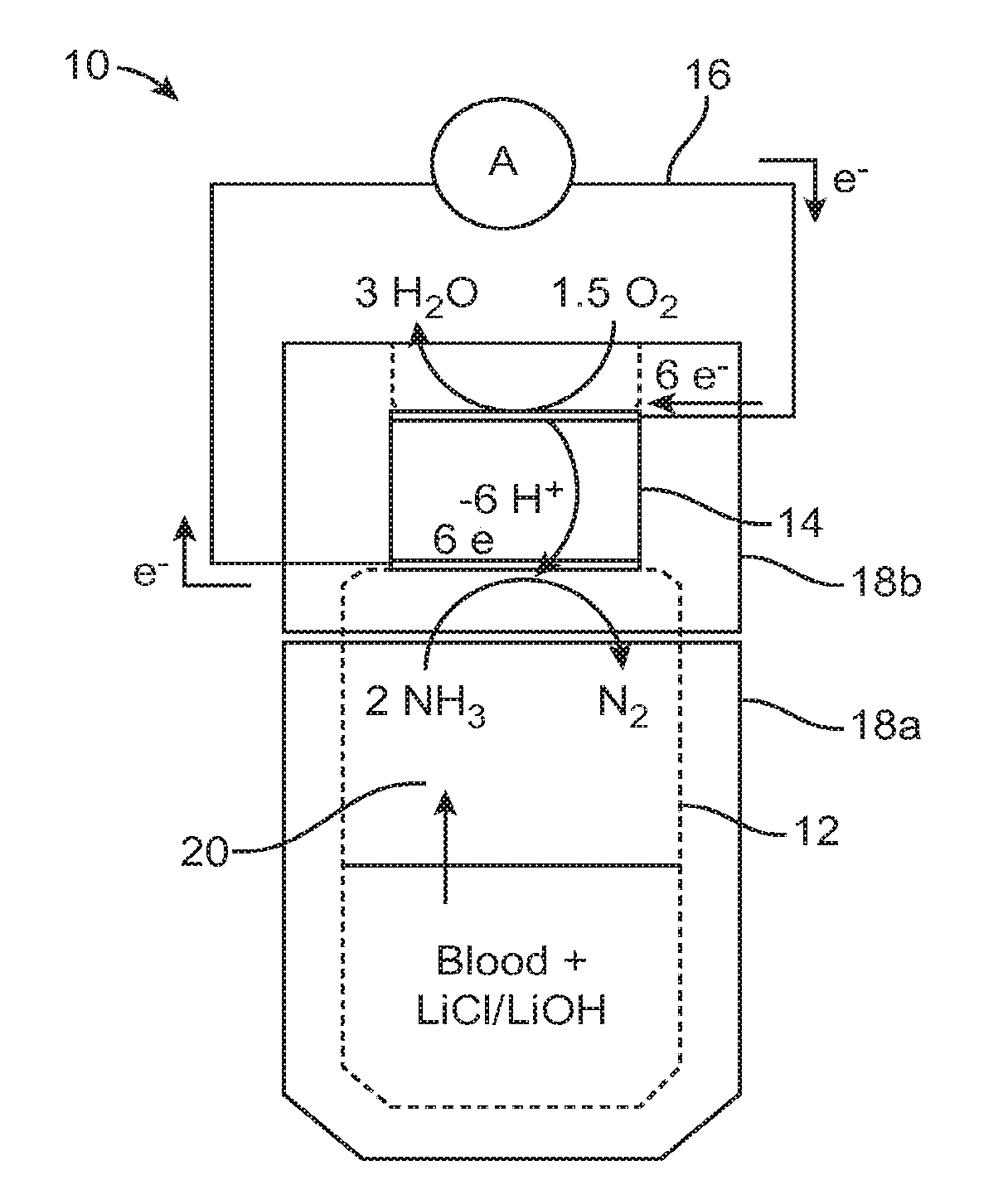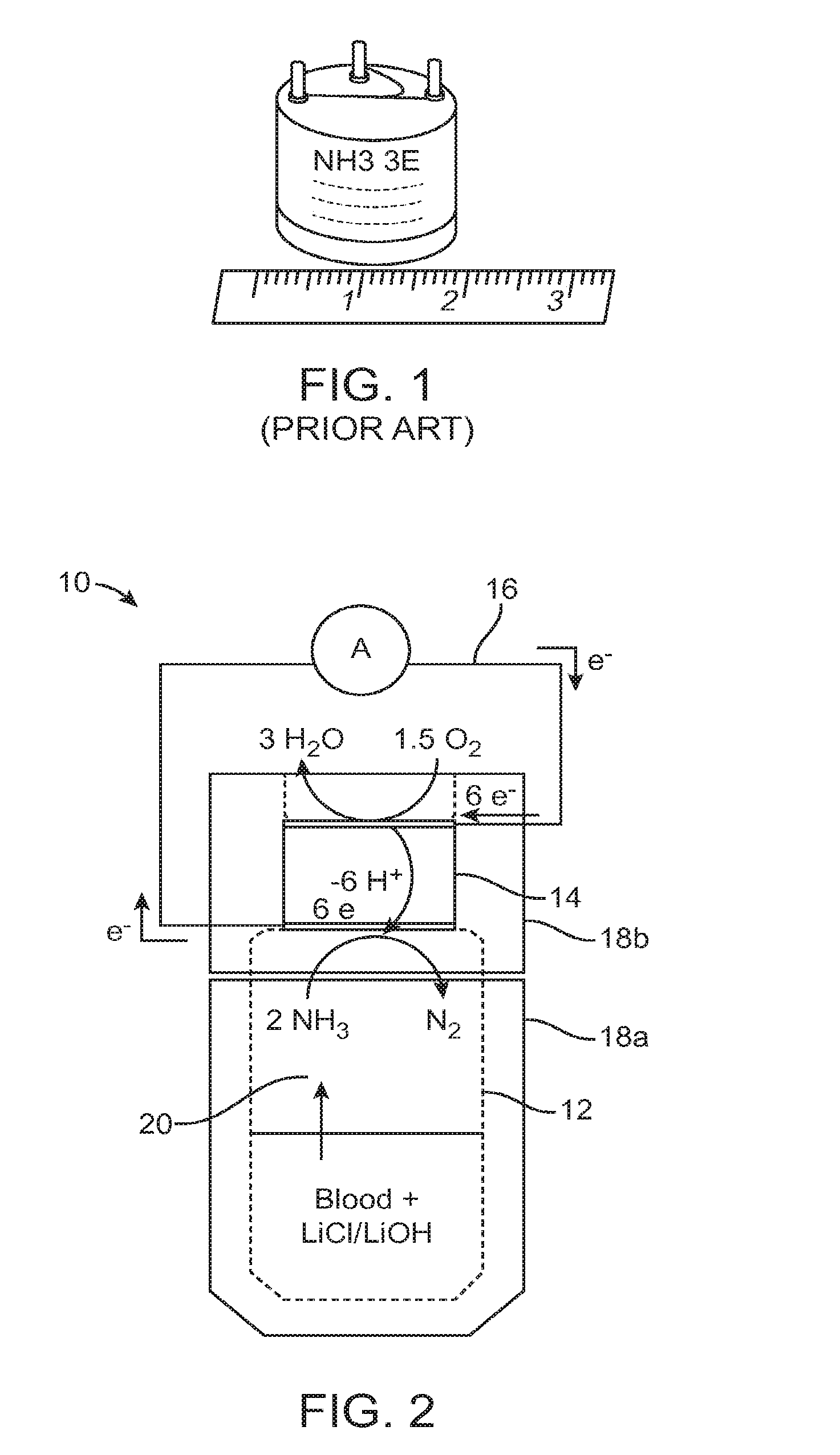Rapid small volume detection of blood ammonia
a technology of ammonia and small volume, applied in the field of rapid small volume detection of blood ammonia, can solve the problems of inability to detect hyperammonia, no current available, brain dysfunction (encephalopathy) and even death, etc., and achieve the effect of facilitating and/or accelerating the ammonia leaving the blood, convenient use, and small volum
- Summary
- Abstract
- Description
- Claims
- Application Information
AI Technical Summary
Benefits of technology
Problems solved by technology
Method used
Image
Examples
experiment # 1
Experiment #1
[0038]An initial set of experiments was performed to optimize the release of NH3 from blood and determine whether device 10 responds linearly to NH3 content in blood. (Anonymous whole blood samples were obtained from the Stanford Blood Bank according to their human subjects protocol.) Rapid responses were obtained by injecting 300 μL of whole blood into sample containment member 12, followed by 180 μL of an aqueous solution containing 0.2 M LiOH and 12 M LiCl (“LiOH / LiCl”). The blood and reagents were mixed with a magnetic stir bar while the current response from the detector was recorded. FIG. 3 shows one example of a typical current vs. time trace for this experiment. Device 10 reached a quasi-steady state current within 3 minutes of the addition of LiOH / LiCl. Unless otherwise noted, this optimized procedure was used for all whole blood analyses discussed below.
experiment # 2
Experiment #2
[0039]A set of blood samples spanning a range of NH3 concentrations was prepared by dividing blood from a single donor into 5 aliquots and adding a different amount of NH3 in the form of NH4Cl to each aliquot. The amount of NH3 added ranged from 0 to 800 μM. FIG. 4 shows the response of the instrument as a function of the amount of added NH3. A smooth linear response was obtained across the 5 samples with a slope of 1 nA / μM NH3. As expected, an appreciable response was obtained for the sample with no added NH3, which reflected the amount of NH3 naturally present in the sample. This experiment demonstrated the ability of device 10 to detect NH3 directly from whole blood and quantify the difference in NH3 content between samples.
experiment # 3
Experiment #3
[0040]Ideally, whole blood analysis of ammonia levels, using the devices and methods described herein, will strongly correlate with NH3 measured for plasma. To address this question, response of device 10 to the NH3 released from whole blood samples was compared to the NH3 concentration in the plasma of the same samples measured by the conventional enzymatic analysis. Fresh 10 mL whole blood samples were obtained from 5 healthy donors at the Stanford Blood Center and transported on ice to the lab. The samples were analyzed in series to minimize the time between whole blood and plasma analysis for each individual sample. An aliquot was removed from the first sample and kept on ice, while the remainder of the sample was centrifuged to separate the plasma. During centrifugation, the whole blood aliquot was analyzed in duplicate with the instrument. The plasma that had been separated was then assayed in triplicate using the conventional enzymatic assay. This procedure was r...
PUM
| Property | Measurement | Unit |
|---|---|---|
| volume | aaaaa | aaaaa |
| current | aaaaa | aaaaa |
| current measurement | aaaaa | aaaaa |
Abstract
Description
Claims
Application Information
 Login to View More
Login to View More - R&D
- Intellectual Property
- Life Sciences
- Materials
- Tech Scout
- Unparalleled Data Quality
- Higher Quality Content
- 60% Fewer Hallucinations
Browse by: Latest US Patents, China's latest patents, Technical Efficacy Thesaurus, Application Domain, Technology Topic, Popular Technical Reports.
© 2025 PatSnap. All rights reserved.Legal|Privacy policy|Modern Slavery Act Transparency Statement|Sitemap|About US| Contact US: help@patsnap.com



